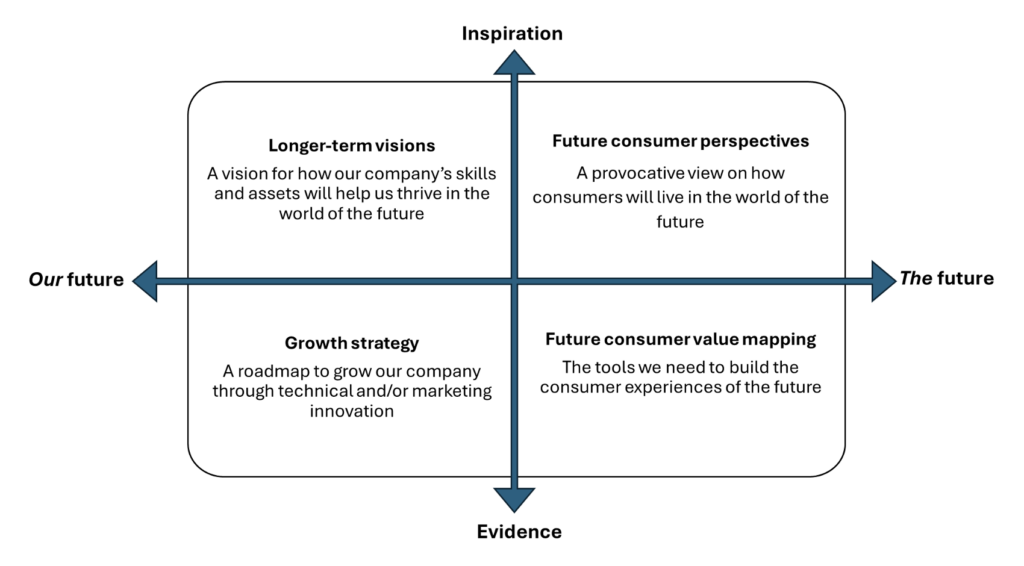Nobody really knows who said, “It’s difficult to make predictions, especially about the future.” Whether it was Mark Twain, Niels Bohr or Yogi Berra, it’s witty, widely quoted and generally believed. But we don’t entirely agree. And nor do our clients, many of whom have approached us recently to conduct research into ‘the future of…’ whether that be a category such as skincare or dairy, a behaviour such as driving or eating out, or a concept such as health or romance.
We’ve seen a flurry of requests for foresight, scenario planning and forecasting of what is coming next. This isn’t surprising when you consider where we are coming from; during the Covid pandemic, marketing and insight professionals were necessarily focused on the present and immediate challenges. After the final lockdown our focus shifted to understanding what had changed and what had stayed the same. Now, our focus has shifted to where to place bets for tomorrow.
We are not saying that it is easy to make accurate predictions, but we don’t think it is impossible either. By piecing together the probabilities of various outcomes we can start to make predictions with an increasing level of confidence. Although we can’t tell you next week’s lottery numbers, we believe there are four types of ‘future of….’ study that can be completed with a great deal of success. However, we find that stakeholders for future-focused studies don’t always have a clear vision of exactly what these studies should cover or how they will be used in the business.
To help decide what type of ‘future of…’ project you need, understand the boundaries of what is possible and, crucially, know how to act on the findings, we have created a set of five questions to ask yourself.

Five questions to determine what type of ‘future of…’ study you need
1. Are we trying to capture our future or the future
Is this project about the emergent needs or solutions in our category or is it broader than that? Are we looking beyond our own category to the wider shifts in people’s lives? For example, is your ‘The Future of Haircare’ study about understanding the haircare choices people make today, as well as emerging trends, so you can project into the near future and make good choices about upcoming product development and marketing? Or is your ‘The Future of Haircare’ study about mapping different scenarios for how people might think about hair in the future, understanding other adjacent categories are evolving and charting a longer-term strategic course for your organisation?
If it is the latter, the future, your research project will focus on consumers and trends, but if it is the former you will need to build in strategic thinking and involve internal audiences in the process; our future is driven by the choices that we make as an organisation.
2. Are we looking for inspiration or evidence?
Is this a creative exercise designed to inspire your organisation around a future vision? Or are you building a statistical decision-making tool to help you make future bets? A vision is something we can start creating for ourselves with the decisions we take today based on research about what that future might look like. But to create confidence for future bets, you need a framework showing where you are today and how things will unfold in the future with variables that can be dialled up and down depending on your appetite for future risk. Such variables might include internal data such as R&D spend or advertising and marketing spend, external economic indicators such as unemployment and interest rates, and consumer data such as uptake of trends or behaviours.
3. Is this about time horizons or capability horizons?
This question is about where the impulse to map the future is coming from within the business. When commissioning a ‘future of…’ study, it can be helpful to try to understand whether you are defining the future as about the internal time horizons of the business or the external horizons of new capabilities and technologies. For example, if it is about trying to map how technical capabilities and new solutions will evolve in the marketplace, this is about capability horizons – technological advancement, supply chain development, new IP and R&D. In contrast, if you are looking to create a consumer-led growth roadmap, this is more about the internal time horizons of the business – what is our marketing strategy and how will we serve consumers with our current capabilities? Time horizons ask the question, “what the world will look like in three or five or ten years?” whereas capability horizons ask, “what can we do within three or five or ten years?”

4. What are we willing and able to do – and what won’t we do?
Much of strategy is making decisions about what you will do in the future, but it is just as important to decide what you will not do. To understand the parameters of this question, ask yourself whether your vision of the future includes a wider world than the one in which you are currently operating? Do you have the capability to disrupt your existing business and – more importantly – do you have the appetite for it? And are there areas which are out of scope? By removing what you know you will not (or cannot) do, you increase the probability of making the right bets.
5. How much is this about taking opportunities and how much is it about avoiding risk?
Future strategy should be about both seizing opportunities and managing risks. However, those of us in marketing and insights tend to be biased towards opportunity and growth – and especially so when we are planning a ‘future of…’ study. It is important to considered risks such as losing relevance with consumers, being repositioned by new competitors or categories, or missing out on the next big macro trend.
There is a tricky balance to be struck between identifying and planning for the big scale existential risks and opportunities whilst not being distracted by the small stuff. In general, people’s needs change more slowly than available solutions, so tightly anchoring your future to growing and evolving needs will put you in a much better place to overcome future unknowns.
And four types of ‘future of…’ study
Having asked yourself these questions, you will be in a strong position to design the type of ‘future of…’ study that you need. The first two questions relate to the axes on our Future Of Research Projects model, below. The remaining three questions help to decide on desirable inputs and outputs in each of the quadrants.

Each quadrant plays out as follows:
1. Inspiration about our future: longer-term visions
Projects in this section need to build in strategic thinking and involve internal audiences in the process, while making it clear that we are not building a roadmap. If the focus is on capability horizons, we also need to involve R&D, but the output will feed into ideation and not into later stage innovation.
2. Inspiration about the future: future consumer perspectives
Projects in this section are focused externally on the market, consumers and trends. The focus is on understanding what the world is doing which contrasts with quadrant one where the focus is on shaping how the organisation acts. These projects give us permission to dream and imagine.
3. Evidence about our future: growth strategy
Projects in this section are the most practical and anchored to our present capabilities. They need to include internal audiences and will result in a roadmap for the future that may be purely technical, purely marketing led or a mix of both.
4. Evidence about the future: future consumer value mapping
Projects in this section are focused externally on the market, consumers and trends but will result in a practical roadmap that helps us build strategy and understand where to invest.
For a ‘future of…’ research project to be successful and actionable, ask yourself the five questions then come and talk to us at The Forge to understand what sort of project you really need.
Image Credits: @mjh_shikder, @robynnexy, @werner01 on Unsplash
